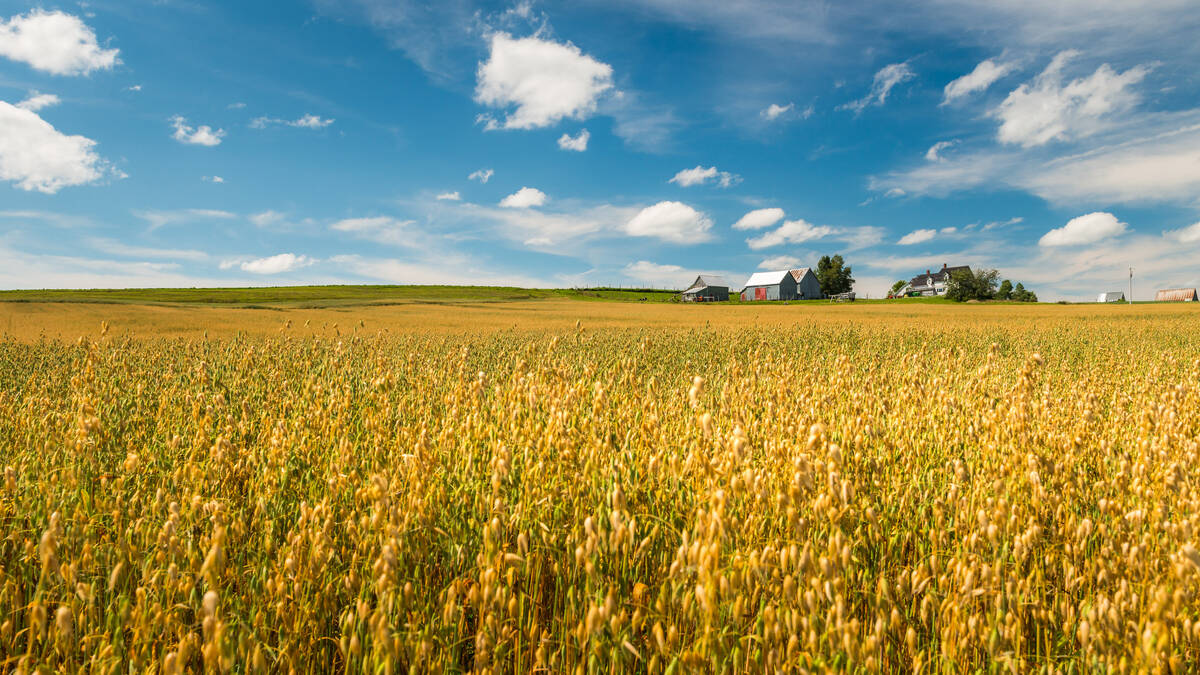Big tractors, big combines, big bins. Everything we thought was progressive about agriculture was always big. So, if few of us expected that one or our most important technological advances would come from turning our clunky rotary-dial telephones into palm-sized communication devices that have many, many times the computing power necessary to land men on the moon, it s entirely forgiveable.
What might not be so forgiveable is if we don t quickly latch onto these new phones, standing on the sidelines while our neighbours get all the benefits.
Read Also

Risk management for the farm means considering people, too
Wheat fields in New Brunswick, Canada.
Although it seems you can t turn around in major urban centres without spotting someone using a smartphone, it s actually farmers who are among the biggest beneficiaries of this earthbound technology, using it to keep track of prices and to market what they produce.
St. Rose, Man. producer Rob Brunel is impressed by how he can sign contracts for canola sales from wherever he is. The industry still has its ups and downs. Some buyers are lagging behind, but there are enough early adopters to make it clear that major changes are underway.
Some companies are more advanced in their policies than others, Brunel agrees. Some don t take your reply back as a signature whereas other companies will take an email reply back as a signature. I think as people move toward using this, maybe we ll see more acceptance of it. It s better than having to go home and print off the thing and fax it back.
Between texting and email, I do a lot more business that way, adds Mark Brock, who farms about 1,500 acres of corn, soybeans and winter wheat in southwestern Ontario. Especially if you re doing a market order for grain, you can call them up and say I want to sell 5,000 bushels, and you just follow it up with an email confirmation.
The Canadian Wheat Board is also keeping up with the smartphone possibilities,
By Richard Kamchen
allowing farmers to use the devices to sign up and lock in its Producer Payment Options (PPO).
We have a number of electronic newsletters, including a weekly PPO Updater with market commentary and a daily PPO pricing e-bulletin that can be emailed directly to a smartphone, says CWB spokesman John Lyons. We are also getting set to launch a mobile Web site that will provide pricing information over a smartphone.
Perhaps the most amazing feature of the technology, however, is the virtually endless variety of farms and farm marketing scenarios where it can open new doors.
That includes helping farmers connect directly with consumers. Allison Decker of the Friends of the Greenbelt Foundation in Ontario led the development of the smartphone version ofwww.greenbeltfresh.ca, a website initiative that is part of the group s objective to build a robust agricultural sector in a ring about Toronto by focusing on local food.
It was something that we built to help farmers and the food service industry, including bulk buyers and institutions, be able to find each other, says Decker, who estimates that 90 per cent of buyers in the Toronto area have either a BlackBerry or an iPhone.
Over half of the greenbelt is rich agricultural land, and cafeterias, nursing homes, schools and restaurants wanted to tap into local food supplies. Just like ordinary consumers, however, they had difficulty connecting to the farmers.
The site s technical capabilities would have been a dream just two years ago. If you re on an iPhone, it can use your current location to help you find what s around you, Decker explains. Users can do a search by vegetable, fruit, meat, dairy or wine. The search engine will pull up the address and integrate with Google Maps to provide directions and lead you from wherever you are.
Already 700 farms are actively updating their profiles on the website.
Pocket office
Thanks to a recent development from the Canadian Cattle Identification Agency, cattle farmers have mobile access to the Canadian Livestock Tracking System (CLTS), allowing them to check their accounts from remote locations.
As a producer, there are times it would be handy to access data in the CLTS, but a computer is not available, says agency chairman Darcy Eddleston. This feature will enable producers to pull up information whether they re in the field, at the auction mart, or in the veterinarian s office.
From their smartphones, cattle farmers can access tag numbers, transaction numbers, animal information, premises information or birth certificates. Users can download and install the application by visiting the iPhone App Store or the Android Market.
It s all part of farmers being able to take their office on the road with them.
I would say my office is on my hip, says Brunel, adding he has had his smartphone for three years and finds he is spending fewer hours on the computer at home. I don t seem to have the time to sit at home and go on the computer much, especially with two young kids, not to mention calving, running a 4,000-acre grain farm, and fulfilling his duties as vice-president of the Keystone Agricultural Producers.
While away from home, Brunel can still keep in touch with the KAP office, whether it s to proofread press releases or commentaries or to read emails from farmers. Brunel also says he uses the Google search engine for research, including mixing instructions.
It s a lot easier to keep on top of things, says Brunel.
The device s camera has also helped him out in the field more than once. He s sent photos to his local agronomist to quickly diagnose crop issues, and during machinery breakdowns, he s taken pictures that he emails to parts dealers who would find the solutions.
Sometimes you get new parts people at the dealership that don t quite know what you re looking at and you send in the picture and away you go. Sometimes we use different terminologies, especially when you come to the combine, and if there s someone new and you re talking about a fan, they could be looking for engine fans, cleaning fans there s all kinds of different fans, Brunel says. But you take a picture, and they grasp exactly what you re talking about, with a lot less frustration.
Brock owns a BlackBerry and an iPad, using them for emailing, texting and applications like unit converters, mortgage calculators, and weather forecasts and radar. He also visits social networking sites like Facebook and Twitter to keep in touch with other farmers.
You always can learn from somebody else, says Brock. It s naive to think that you have all the answers.
Twitter also allows him to get market updates wherever he is. I like that because you might be in the throes of something that seems important to you, he explains. Then you might get a tweet on a market happening that you weren t aware of that might help you, and you call up your guy to, say, sell four contracts.
Market advice
Grain marketing consultant Mark Lepp, co-founder and business manager of FarmLink Marketing Solutions in Winnipeg, is among the growing list of advisers who send out market related messages on Twitter, as well as text messaging futures news and sales recommendations.
For instance, if we recommend selling 20 per cent of new-crop canola, a text message goes out to only our canolagrowing clients saying something like this, We are recommending selling 20 per cent of new crop canola. Contact your marketing adviser or read your CropLink Update newsletter, Lepp says.
FarmLink began offering its smart-phone options two years ago and provides a mobile web page with futures quotes, backed up with emails describing futures market events of the day as well as crop specific newsletters.
By sending them out crop specific, clients only get the CropLink Updates they want, and they can view these on their phones easily, says Lepp.
There is also an online tool which allows clients to view everything Farm- Link keeps track of on their farm production, crop budgets, the year s marketing plan, and cash flow planning. FarmLink also tracks every sale with whom, how many bushels, and sale value.
There is an incredible amount of information out there and smartphones are a great way for farmers to utilize these resources to help them with marketing and use them as a critical tool in a marketing plan, Lepp says. Farmers hire us to have FarmLink go through as much information as we possibly can and make it relevant to them in a clear, concise manner.
Ag-Chieve is another advisory service that has grabbed hold of the smartphone trend. Among other things, Ag-Chieve provides text alerts and sales recommendations, which can lead to a full several minute long streaming audio-visual presentation and PDF summary. Farmers can also dial their 800 number and talk to one of their advisers, using them as a sounding board or getting more detailed analysis.
Our model is, we ve got the analysis and the advice and we ll deliver it to you in whatever way is convenient and most effective for you, says chief operating officer Bill Smith, pointing out Ag-Chieve offers fax, text and email delivery options. We approach it from the point of view that with a minimum of clicks and knowledge of technology you should be able to get what you want quickly and easily.
Smith says one of the main advantages is that the smartphone can turn idle time into productive time staying on top of the markets or developing grain marketing strategies. He was around during the Internet s expansion for popular usage in the 1990s and says he is surprised by how far things have come.
Pulling the BlackBerry or iPhone out of your pocket and being able to fully connect with all the latest information in whatever kind of technology you want it s no flying car, but it s pretty valuable to a farmer, says Smith. To stay on top of the markets, sometimes 10 or 15 minutes can make a difference either way, and this is the platform that seems to hold out the most promise. CG
———
Protect your handset& and your data
You learn to be more aware of your phone and try to protect it by not exposing it to extreme conditions, said St. Rose, Man. farmer Rob Brunel. My biggest beef with a lot of the technology available is they don t like dust, they don t like moisture, and they don t like being dropped. They re very handy but they also can be costly to replace.
There are casings that can be purchased, or the more expensive option of finding a specially built handset that has a casing built into it. But you probably won t be able to buy that from a standard carrier, said University of Toronto computer prof Eugene Fiume.
One of the things you can do that the carriers never tell you is that you can always buy your own phone, Fiume says. With the appropriate card, just buy the appropriate service from the provider. And certainly you ll see that in a lot of industrial applications where people will have pre-ordered special handhelds that either have to all be exactly the same for some particular use within a company, or need to be rugged-ized.
Because handhelds can be fragile, Fiume says the device should synchronize easily and effectively with your desktop or laptop. That will help prevent data loss, and it will also help you get your new phone loaded so you ve got minimal down time.
Synchronization can be made to be automatic each time the handheld is plugged into the desktop computer with a USB connector. But there are other options of doing this, Fiume says, so make a point of discussing it with your vendor.













